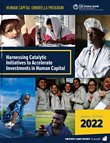What Are Human Capital Reviews?
The Human Capital Reviews (HCRs) are World Bank's analytical products that support countries improving their investments in people. These reports provide a comprehensive view of the state of human capital in a country, assess endowments and constraints to human capital development across a broad range of areas, such as healthcare, education, labor markets, and identify priority human capital outcomes that require improvement. HCRs provide integrated multisectoral analysis of human capital spanning topics relevant to build, protect, and use human capital across the lifecycle.
























